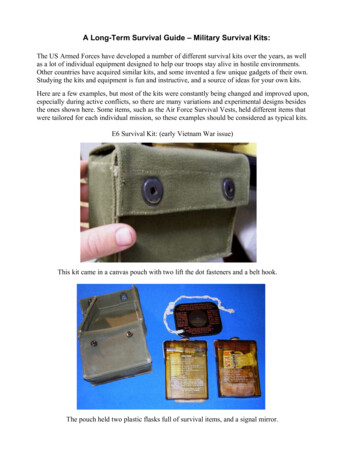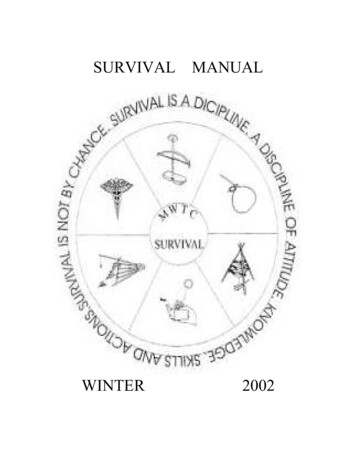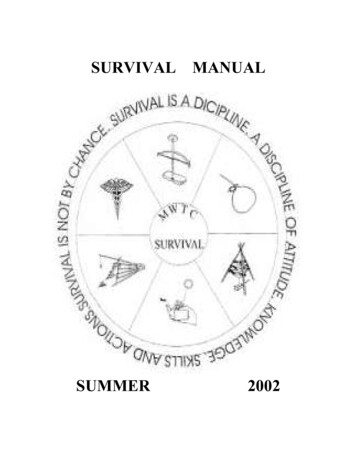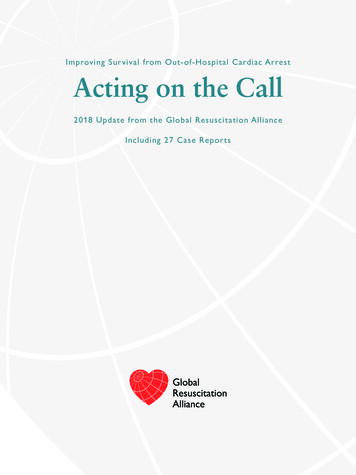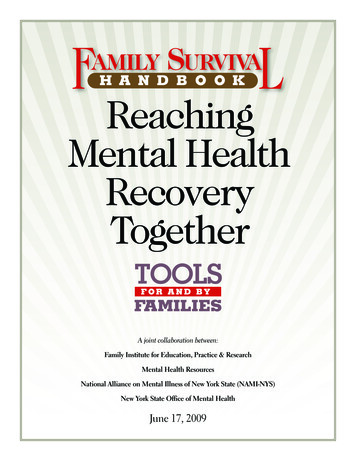
Transcription
ReachingMental HealthRecoveryTogetherTOOLSA joint collaboration between:Family Institute for Education, Practice & ResearchMental Health ResourcesNational Alliance on Mental Illness of New York State (NAMI-NYS)New York State Office of Mental HealthJune 17, 2009
FA M I LY S U R V I VA L H A N D B O O KReaching Mental Health Recovery TogetherFamily Survival Handbook:Reaching Mental Health Recovery TogetherTools for and by familiesA joint collaboration betweenFamily Institute for Education, Practice & Research, Mental Health Resources,National Alliance on Mental Illness of New York State (NAMI-NYS),New York State Office of Mental HealthContentsABOUT THIS HANDBOOK .1INTRODUCTION .3THE FAMILY EXPERIENCE OF MENTAL ILLNESS .3HOSPITAL CARE - WHAT TO EXPECT .5Confidentiality - Getting consent.5Participation without consent .6Treatment Team .6Family members as partners with the treatment team.6Roles and Responsibilities: Achieving Treatment Plan Goals .7Treatment Plan .8Cultural issues and support.8How to get hospital records .9What to do if you’re dissatisfied with your loved one’s care .9I
FA M I LY S U R V I VA L H A N D B O O KReaching Mental Health Recovery TogetherPAYING FOR IT ALL .11Introduction to Social Security Disability Insurance and Supplemental Security .11Income .11Medicaid Buy-in Program for Working People with Disabilities .11How to get Food Stamps .12How to get a Reduced Fare card.12DISCHARGE PLANNING: IMPORTANT CROSSROADS.13Assisted Outpatient Treatment (AOT) .13Emergency Planning (Crisis plans, WRAP and Advance Directives).14Family Contract.15Housing .15Housing application in NYC & State pgs .15Types of housing.16GETTING WELL, STAYING WELL .17Rehabilitation .17Living with a loved one out of the hospital .17Sticking with medication.18Don’t forget physical Health .18Education and support programs .19Cognitive Rehabilitation .20Nutrient approach to mental illness: Complementary and Alternative Medicine (CAM) .20Employment .21Empowerment and the Peer Movement .22Recovery.23II
FA M I LY S U R V I VA L H A N D B O O KReaching Mental Health Recovery TogetherTOOLS YOU CAN USE .25Hospital Checklist .25Management Log Sheets .35Sample form: Family Contract .36RESOURCES.37CONTRIBUTORS.49III
FA M I LY S U R V I VA L H A N D B O O KReaching Mental Health Recovery TogetherIV
FA M I LY S U R V I VA L H A N D B O O KReaching Mental Health Recovery TogetherAbout this handbookhe Family Survival Handbook is a collection ofpractical, useful information contributed by over65 family caregivers from New York City and Statewho have learned from experience how to navigate thepublic mental health system in New York State. Intendedfor use by families when a loved one is first diagnosed,admitted to a hospital, and after his/her discharge, thishandbook’s purpose is to provide information and resources while guiding users with informative tips designed to enable them to:G Access educational materials;*G Build a support network;G Advocate for their loved one;G Become meaningfully involved with their lovedone’s treatment team,G Participate in the development of meaningful, recovery-oriented Treatment and Discharge Plans;G Become informed about the spectrum of servicestheir loved one might need,*G Enable them to both request these services andaccess them themselves, as necessary*With its companion pamphlets, When FamiliesJoin the Mental Health Care Team Everyone Benefits!,and how-to guide, Understanding HIPAA, NYS MentalHygiene Law and the Confidentiality of Mental HealthTreatment and Information in New York State, this Handbook will provide you with essential tools to help you better understand the many aspects of the mental healthsystem so you can effectively support your loved one whilehe or she navigates the mental health system. Whetherhe or she is experiencing a “first break” (i.e., first episodeof psychosis or first admission to a psychiatric ward) or arelapse, these materials will arm you with informationabout laws, policies, professional guidelines and resourcesto make your involvement in your loved one’s recoverydynamic and effective. Because this Handbook is focusedon a team approach to recovery, we encourage sharing allor part of it with your family member, as well as with theproviders that are caring for your loved one.surance benefits. Part Two includes resources and reading lists, as well as tools such as the Hospital Checklist(pale green paper)and Management Log Sheets (pale yellow paper) to help you record important information,and capture and organize documents, in one easy-tolocate place. Part Two also includes resource and readinglists. We encourage you to make use of the Handbookduring all meetings and telephone calls with mentalhealth professionals, and use the Pamphlet and How-toguide on the inside flap of this Manual as a basis for youradvocacy efforts.The Handbook uses the following logos to make iteasy to find the information you need:TRThe Resource Logo identifies where you canfind additional information about a particular topic, such as contact information, linksand/or websites. This information is locatedin the “Resource” section in the back of theHandbook.The Toolbox Logo alerts the user that the referenced worksheet can be found in the“Tools You Can Use” section in the back ofthe handbook. These tools include:G The Hospital Checklist: this is a worksheet youcan use to store all pertinent information regarding your loved one and his/her treatment. It iscritically important to have this information readily available when your loved one is hospitalized.The Checklist provides space where you canrecord information including your loved one’scontact information, the names/ contact information of mental health professionals who havebeen involved in providing care to him/her, diagnoses, status of government benefits, treatmentgoals, medication lists and discharge planning.This Checklist, which is printed on pale greenpaper and is located at the back of the Handbookin the “Tools You Can Use” section, will arm youwith the facts you need to intelligently and effectively represent your loved one if he or she is hospitalized, and ensure the hospital has the criticalinformation it needs to provide quality care.*HOW DOES IT WORK?The Family Survival Handbook is organized into two sections. Part One highlights information you may need toquickly access, such as how to obtain your loved one’sconsent to have his/her treatment information disclosedto you, or how to apply fÏor supplemental income or in1
FA M I LY S U R V I VA L H A N D B O O KReaching Mental Health Recovery TogetherPamphlet and How-to guide on inside flap:G Management Log Sheets: These forms can serveas your “working papers” where you can record achronological list of people with whom you speakwith respect to your loved one’s care, noting whatwas said and what determinations were made,both in and out of the hospital setting. Thesesheets, which are printed on pale yellow paperand are located at the back of the Handbook inthe Tools You Can Use section, will help yourecord information that may be difficult to recallor gather at a later time. Information documented on these sheets can form the foundationfor future dialogues, inform the decisions madeby future treatment teams, and serve as a record ifever you need to file a complaint. If you needhelp in completing these forms, we recommendthat you ask a hospital social worker or case manager to assist you.It’s not possible to advocate for your rights if you don’tknow what they are. The materials below, which areavailable in the side flap of the Handbook, not only apprise you as to what your rights are, but can serve as powerful tools for your advocacy efforts:G When Families Join the Mental Health CareTeam Everyone Benefits!G Understanding HIPAA, NYS Mental HygieneLaw and the Confidentiality of Mental HealthTreatment and Information in New York State2
FA M I LY S U R V I VA L H A N D B O O KReaching Mental Health Recovery TogetherIntroduction:Your loved ones in the hospital.Now what?INDING OUT YOUR LOVED ONE has a mental illness may be the toughest experience of yourlife. Few families are prepared or equipped to handle the traumatic and demanding responsibility suddenlythrust upon them. You are in an unfamiliar world with nocompass to guide you. Yet, you must immediately become an advocate as you find information, locate services, navigate the mental health system, and manage theemotional, social and financial consequences of mentalillness that affects everyone involved. How will you cope?Here’s the good news. Never before have weknown so much about mental illnesses and how to enable people living with the diseases to live, work, learnand participate fully in the community. Long-term studies have consistently shown that over half of people diagnosed with major mental illness go on to a significant orcomplete recovery. The new field of neuroscience isproving that the brain can regenerate to a greater degreethan was previously thought possible. Significant advances in research are providing a wider range of medications and psychosocial treatments that offer tools forself- and peer- help. Meanwhile, the mental health system is beginning to accept the truth that recovery is possible, particularly with support from peers, family andcommunity. For the first time, optimal well-being or“wellness,” not just absence or reduction of symptoms, isthe goal of mental illness treatment.Despite gains made in recent years, challenges remain. Although research and everyday experience hasshown recovery occurs best when treatment professionals, the family and the patient work together, much of theinformation needed by consumers and families is still noteasily accessible. This means families not only have tolearn what information they need, but they must alsowork hard to get it and understand how to use it.Successful families learn how to advocate, whichmeans to “plead the cause” to “argue, defend, recommend.” In order to stand up for what your loved one deserves, you must know. You must know the laws thatgovern their, and your, rights, and you must be persistentand vigilant to ensure that facilities comply with them. Tosome degree, the services you get will be the ones youfight for and insist on.FIn this time of economic hardship, families have tofill the gap left from diminishing services. Families mustbe resilient and self reliant—we need to help ourselvesand our loved one as never before.We know we are throwing a lot of ideas and possibly unfamiliar language at you all at once. First-timersmay want to initially focus on the Hospital Care/PayingFor it All/Discharge Planning sections located in the frontof the Handbook. Our goal, however, is to provide a reference to enable you to become familiar with the entirespectrum of what you’ll potentially have to deal with.There is a huge amount of help for you in the mentalhealth system, but it’s up to you to find it and use it. ThisHandbook can empower you to ask informed questions,track the professionals’ progress, have the tools to takeover when necessary and even be ten steps ahead of thegame! We hope, with this Handbook reference, questionswill be answered for you in a way that they haven’t beenfor families in the past.NOTE: We use the term “Loved One,” “Consumer,” “Patient” and “Peer” interchangeably.FAMILY EXPERIENCEOF MENTAL ILLNESSHEN MENTAL ILLNESS STRIKES, it is afamily affair. Regardless of who carries the symptoms, the event is a catastrophic one that affectsall family members. Therefore, the entire family needsto be involved. The ill family member must be supportedand stabilized. Well family members need assurance thatthey are not to blame for their loved one’s circumstanceand that the situation is not hopeless.Most often, when a loved one has been hospitalized, he or she is experiencing symptoms and may displaybehaviors that can make them seem unrecognizable—even to family members who have known the person allof his/her life. Educating yourself about the nature ofmental illness will give you a window into your lovedW3
FA M I LY S U R V I VA L H A N D B O O KReaching Mental Health Recovery TogetherGETTING SUPPORT:OTHER FAMILIES ARE THE BEST SUPPORTone’s struggle and help you understand that their illnessis not their identity.A mental illness can rob your loved one ofstrengths, coping skills and cognitive abilities—which arethe basic mental skills we use to think and learn. In fact,your loved one may not realize he or she is sick, displaying a common symptom called Anosognosia or “lack ofinsight.”Some people have one episode of mental illness andthen get on with their lives with little or no impairment.For others, these disorders of the brain can be lifelong illnesses, with a level of disability ranging from modest to severe.The process and outcome of mental illness cancause family members to cycle through feelings of hopeand despair. While it is a normal part of the family recovery process, shifts in feelings can be extreme, painfuland confusing.One of the most useful sources of support for families is. other families!. Families can experience one ormore of the following stresses when coping with mentalillness in the family: financial, interpersonal, marital, social, emotional, physical and/or spiritual. Sharing experiences and feelings in family support groups can reducetension and help identify solutions that others with similar experiences have found useful.And don’t wait! Experienced caregivers say joininga good support group as early as possible is critical. Overtime, you must learn to create a balanced life for yourselfand other well family members, even as you care for thefamily member who is ill.NAMI’s signature Family-to-Family Program is afree twelve-week course offered by National Alliance onMental Illness affiliates or chapters all over the country.Call them at NAMI-NYS at (518) 462-2000 or 800-9503228 to locate the one nearest you.LACK OF INSIGHT:THERE’S NOTHING WRONG WITH ME1Your loved one may not realize he is ill. Instead, hemay actually believe his delusions and hallucinations are real. The term used by neurologists is“anosognosia,” which comes from the Greekword for disease (nosos) and knowledge (gnosis),literally meaning, “to not know a disease.”Here’s what we know about anosogosia:G It is not denial, but a symptom of illness.G It is caused by damage to specific parts of thebrain, most likely the frontal and parts of theparietal lobe.G It affects approximately 50% of individualswith schizophrenia and 40% of individualswith bipolar disorder.G Individuals can be partially aware or fluctuate,being more aware when they are in remissionand less aware when they relapse.G It is the single largest reason why individualswith schizophrenia and bipolar disorders donot take their medications.G Medications can improve awareness in somepatients.SUPPORT GROUPSThe time to join a support group is right now.Here’s what they can offer:G Emotional supportG A break from isolationG An outlet for from the range of emotionalstresses named aboveG How-to informationG A chance to compare notes on local services*G Ability to draw on the experience of others*G Opportunity to work through the “Stages ofGrief”, including denial, anger, bargaining, andacceptance.4
FA M I LY S U R V I VA L H A N D B O O KReaching Mental Health Recovery TogetherHOSPITAL CAREThe extent and depth to which you are involvedwith your loved one’s treatment could affect the course ofhis or her illness. One main goal of this section is to showyou what you should expect to be entitled to, and how toget what you deserve.N THE CASE of an airplane crash landing, adult passengers are instructed to first put the oxygen mask ontheir own faces and then help their children withtheirs. Likewise, when mental illness hits, families willbe in the best position to help an ill family member ifthey make sure they take care of themselves and othermembers of the family.The dictionary defines rehabilitation in this way:“To restore to a state of physical and mental healththrough treatment and training.” For families, rehabilitation is about acquiring information and education,working through feelings and reaching acceptance,while learning ways to help the family rebuild.Rehabilitation is a process that begins in the hospital and continues after your loved one’s discharge. A rehabilitation program includes many components (see“Rehabilitation” on page 21). Several activities thatshould take place while your loved one is hospitalized andimmediately after his/her discharge:1. The patient and his/her family should receivetimely education about the illness and the importance of staying on medications.2. The family should immediately become involvedwith the patient’s Treatment Team, as authorizedby the patient.3. The patient, and family members as appropriate,should attend programs and post-discharge meetings to monitor the patient’s illness, watch forearly signs of relapse, and obtain support and information.ICONFIDENTIALITY—GETTING CONSENTIn general, an adult competent patient must give permission to the hospital before a family member can beprovided with information about the patient’s case. TheFederal Health Insurance Portability and AccountabilityAct (HIPAA) and New York State Mental Hygiene Lawwhich protect the confidentiality of patient informationare unfortunately misunderstood, and sometimes evenmisused, to create an artificial barrier to family involvement in a loved one’s treatment.Under HIPAA, persons have the right to “agree orobject” to disclosures to family members or persons involved in their care. Similarly, New York State’s MentalHygiene Law state that patient “consent” must be givenbefore disclosures to family members can be made., butthe actual form the “consent” must take is not specified.Therefore, as a general rule, an adult patient must givepermission before families can be provided with information about them, and the fact that this permission hasbeen obtained should always be documented.INFORMATION NEEDS OF FAMILIESGGGGGGGGGGWhile your loved one is in the hospital, make sure you find out the following information:What is the patient’s psychiatric diagnosis (for example, schizophrenia), and what does it mean?What is the patient’s treatment plan for the psychiatric disability?What are some ideas and strategies on how to prevent a relapse?How can symptoms be identified?What resources and supports are available?What are some sources of personal stress and how can they be addressed?What is the family recovery process?What family/patient self-help/ advocacy groups are available?What are the legal issues to be aware of , e.g., patient rights, trusts and commitment laws?Record the specifics in the Hospital Checklist pgs. 32-40, on pale green sheets at back) and the Management LogSheets (pgs 41 on, on pale yellow sheets at back)5
FA M I LY S U R V I VA L H A N D B O O KReaching Mental Health Recovery TogetherFIRST THINGS FIRST - TRY TO GET CONSENT!Confidentiality rules reflect the fact that health and mental health information is sensitive. These rules are designedto protect the privacy of the person to whom the information pertains. As a general rule, competent adult patients(age 18 years of age and older) have the right to choose with whom their medical information is shared.In order to allow the hospital to share confidential information with family members, your loved one should sign a“consent form.” Although consent can be made verbally (and should be documented in his or her clinical record), ifsomething is not in writing, it is harder to prove it exists. Having a signed consent form in hand will increase yourability to fully participate in confidential aspects of your loved one’s treatment and discharge planning.On the inside flap you’ll find Understanding HIPAA, NYS Mental Hygiene Law and the Confidentiality of MentalHealth Treatment and Information in New York State. For the first time, this “how-to” guide addresses many issuesaround when and how family can work with the mental health team, whether or not with patient consent. In plainEnglish, with lots of examples applicable for consumers, family and providers, this exhaustive look includes suchsubjects as:G What is the difference between NY State Mental Hygiene Law and HIPAA?G What are the rules that govern disclosure of clinical records?G How can family provide important information, even without the patient’s consent?G Why is confidentiality an important principle in health care; what is the Hippocratic Oath?*A complete guide to the Confidentiality of Mental Health Treatment and Information is provided in the inside Flap:—Understanding HIPAA, NYS Mental Hygiene Law and the Confidentiality of Mental Health Treatment and Information in New York StatePARTICIPATING WITHOUT CONSENTpermission for them to be on the team and have accessto confidential treatment information.If the patient will not give consent to a family membervoluntarily, here’s what you need to know:1. General information (such as mental health informational materials or information about community resources) is not confidential and can betremendously helpful to family members.2. Staff may discuss a range of subjects in a generalfashion, provided they do not reveal specific information about the patient, such as the availableprograms offered by the hospital, or general procedural information, such as how privileges canbe obtained. .FAMILY MEMBERS AS PARTNERSWITH THE TREATMENT TEAMFamily members are often called upon to play a significantrole in the support of their ill family member. Becausefamily members can have insight that is incredibly valuable to the treatment team, such as family health history,the history of a loved one’s illness, the patient’s currentTIP: Although professionals might not be able to talkto you if your loved one has refused to sign a consent form, there is no reason why they shouldn’t listen to you, directly or by phone, fax or email (pleasenote some facilities may require that communications that include patient identifying information bemade in a secure fashion to protect patient privacy) .Also, staff may share information provided by thefamily to the patients, such as messages of support,unless the doctor does not allow itTREATMENT TEAMThe term “treatment team” usually refers to those employees of a facility who are responsible for the direct careof a patient (doctors, case managers, psychiatric nursesetc.). Sometimes, the treatment team can be expanded toinclude outside specialists such as vocational rehabilitation providers. However, the patient usually must grant6
FA M I LY S U R V I VA L H A N D B O O KReaching Mental Health Recovery Togetherstrengths and deficits, what was the level of his/her functioning before the onset of the illness, and/or knowledge oftheir loved one’s use/abuse of alcohol or illegal substances,they are an important resource. Family involvement andcollaboration with the treatment team should be activelyencouraged and supported whenever appropriate.Unfortunately, some facilities may not encouragefamily involvement with the treatment team, eventhough organizations such as the American PsychiatricAssociation recognize in their guidelines the considerable benefits to treatment of doing so: “A guiding principle is that the patient’s family members should be involvedand engaged in a collaborative treatment process to thegreatest extent possible.” (American Psychiatric Association, Practice Guidelines for the Treatment of Patients withSchizophrenia, second ed., 2004, pp. 70, 106).Furthermore, with respect to facilities operated bythe New York State Office of Mental Health, Section29.13 of the Mental Hygiene Law requires the development of a written treatment plan. The treatment planoutlines treatment goals, what programs or therapies willbe undertaken to achieve these goals, and a timetable forassessing progress. Under this law, parents of minors inOMH operated facilities must be involved in the development of a treatment plan, (unless the minor is over 16years of age and objects to such participation, and a clinician determines it is not clinically appropriate to involve them). If an adult patient in an Office of MentalHealth operated facility requests that a family memberbe involved in the development of his/her treatmentplan, that person must be included in its developmentOther accrediting organizations, such as The JointCommission, have stated that “patients and, when appropriate, their families [must be] informed about theoutcomes of care, treatment and services.” (The JointCommission, Comprehensive Accreditation Manual forHospitals (CAMH), 2006, §RI.2.90, second ed., 2004)All of these references, as well as others,
FAMILY SURVIVAL HANDBOOK Reaching Mental Health Recovery Together I Family Survival Handbook: Reaching Mental Health Recovery Together Tools for and by families A joint collaboration between Family Institute for Education, Practice & Research, Mental Health Resources, National




